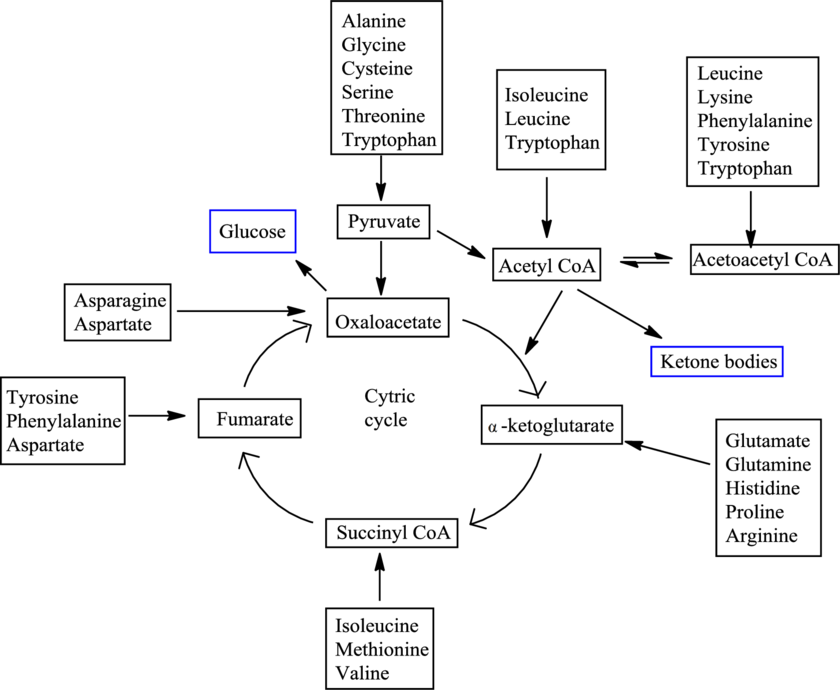
Concept explainers
Interpretation: To identify the correct pairing of standard amino acid carbon skeleton degradation product and amino acid genicity.
Concept introduction: Genicity of an amino acid is defined as whether the carbon skeleton degradation product of an amino acid can produce glucose or
There are 20 standard amino acids and each has a different carbon skeleton. An amino acid is known as a glucogenic amino acid if its carbon-containing degradation product can be used to produce glucose. An amino acid is known as a ketogenic amino acid if its carbon-containing degradation product can be used to produce ketone bodies.
The degradation pathways for different amino acids merge in between and result in the formation of only 7 products. The 7 products are
Fates of carbon skeletons of different amino acids are as follows:

Want to see the full answer?
Check out a sample textbook solution
Chapter 15 Solutions
Organic And Biological Chemistry
- 22. The complete hydrolysis of a protein yields what as products? a. amino acids b. dipeptides C. monosaccharides d. glucose molecules e. no correct responsearrow_forwardAmino acid metabolism differs from that of carbohydrates and Fats in that * (a) There is no storage form for amino acids in the body (b) Amino acids cannot be used for energy production (c) Amino acids cannot be converted to acetyl CoA. (d) No correct response.arrow_forwardWhich of the following polysaccharides contain both alpha 1 → 4 and beta 1 → 4 linkages? a. amylose b. cellulose c. amylopectin d. more than one choice is correct e. no correct response The cellular fluid in the interior of a cell is known as the a. cytoplasm b. matrix c. organelles d. lipid bilayerarrow_forward
- Which of the following statements concerning the degradation of standard amino acid carbon skeletons is correct? a. Each type of carbon skeleton is degraded to a different product. b. All carbon skeletons are degraded to the same product. c. Each type of carbon skeleton is degraded by a different metabolic pathway. d. no correct responsearrow_forwardHormone-sensitive lipase needed for triacylglycerol mobilization is activated by a. epinephrine b. cAMP c. adipocytes d. no correct responsearrow_forwardwhich of the following processes is glucose 6-phosphate the end product? a. more than one correct response b. glycogenolysis c. glycogenesis d. glycolysis e.no correct responsearrow_forward
- 24. In the following diagram, the rate of an enzyme-catalyzed reaction is graphed on the y (or vertical) axis versus another quantity on the x axis. What quantity is graphed on the x axis? a. substrate concentration Ob. reaction pH Oc. reaction temperature Od. more than one response is correct e. no correct responsearrow_forwardIn the degradation of heme, the iron atom present is released and then a. eliminated from the body in the urine b. captured by the iron-storage protein ferritin c. captured by the B vitamin niacin d. no correct responsearrow_forwardQuestion 15 Glycogen storage disease type I (GSD I) or von Gierke's disease, is the most common of the glycogen storage diseases. This genetic disease results from deficiency of the enzyme glucose-6-phosphatase. The metabolic outcomes of GSD I are likely to include: O Low blood glucose, increased blood pH, increased glycogen storage in liver and kidneys O High blood glucose, decreased blood pH, decreased glycogen storage in liver and kidneys O Low blood glucose, increased blood pH, decreased glycogen storage in liver and kidneys O Low blood glucose, decreased blood pH, decreased glycogen storage in liver and kidneys High blood glucose, decreased blood pH, increased glycogen storage in liver and kidneys O High blood glucose, increased blood pH, increased glycogen storage in liver and kidneys O High blood glucose, increased blood pH, decreased glycogen storage in liver and kidneys O Low blood glucose, decreased blood pH, increased glycogen storage in liver and kidneysarrow_forward
 Organic And Biological ChemistryChemistryISBN:9781305081079Author:STOKER, H. Stephen (howard Stephen)Publisher:Cengage Learning,
Organic And Biological ChemistryChemistryISBN:9781305081079Author:STOKER, H. Stephen (howard Stephen)Publisher:Cengage Learning, General, Organic, and Biological ChemistryChemistryISBN:9781285853918Author:H. Stephen StokerPublisher:Cengage Learning
General, Organic, and Biological ChemistryChemistryISBN:9781285853918Author:H. Stephen StokerPublisher:Cengage Learning


